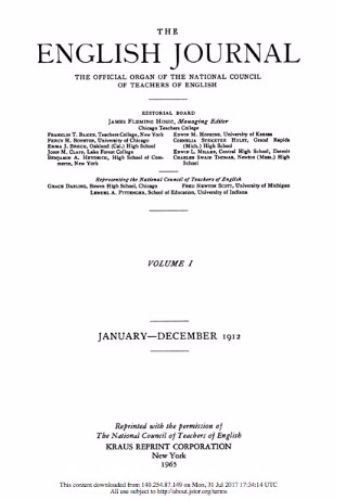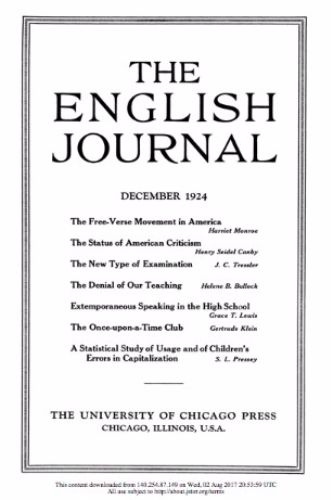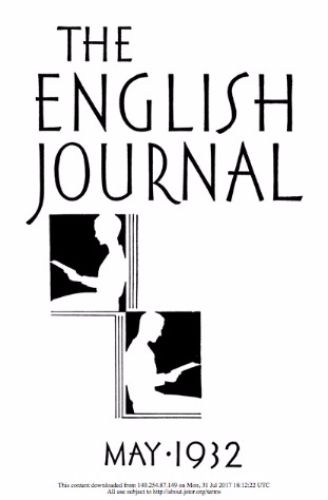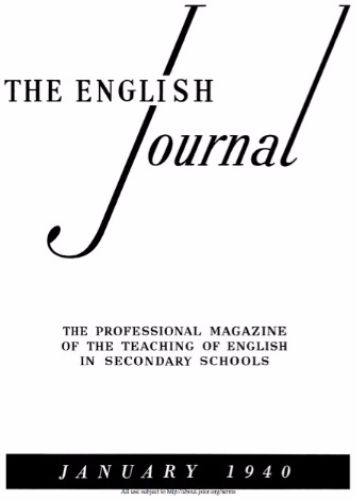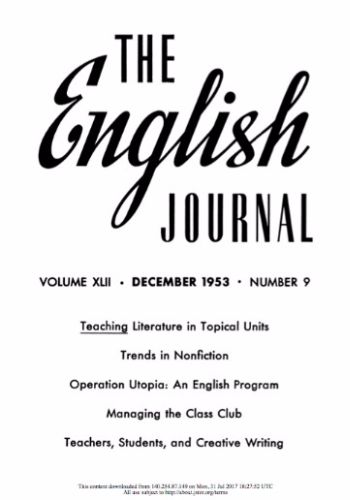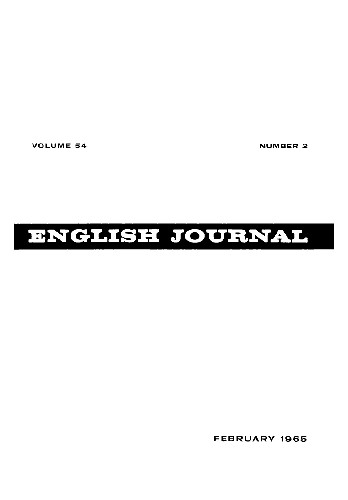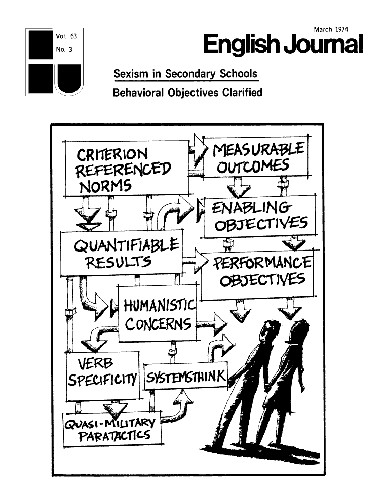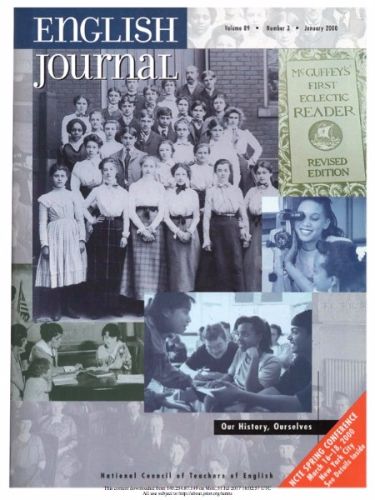A Distant View of English Journal, 1912-2012
Jason Palmeri & Ben McCorkle

LOOKING BACK: AN INTRODUCTION
Looking back through the archives of English Journal, the longest continually running publication in English education, is akin to studying a petri dish colonized by the wee beasties of technologies past and present. Through the lens of a microscope, one can observe a landscape teeming with magic lanterns, stereoscopes, Super 8 cameras, phonographs, radios, tape recorders, televisions, and word processors, to name only a few of the technologies one can find there. By taking a more distant view of English Journal—100 years' worth, in fact—we are able to examine one specific site for historicizing how the field of English studies has responded to the presence of communication technologies and their resultant media forms as they emerge, wax, wane, and recede from our collective view over time.
Academic fields of teaching and study such as "English" or "computers and writing" or "digital humanities" do not emerge into the world fully formed, but instead develop over considerable periods of time. Oftentimes, those changes are covered over with the dust of history, making it difficult to understand how we have come to be where we are today. This inevitable process of historical erasure leads to the creation and propagation of unexamined assumptions about the values associated with the discipline—say, for example, the common notion that it was the introduction of personal computers that ignited English studies' interest in multimodal literacy. Yet, when we systematically review the past 100 years of writing about media technology in English Journal (the longest running journal dedicated to English pedagogy at all levels), we can uncover a long history of visual and audio media pedagogies in the field. We can track moments when media composing pedagogies flourished as well as moments when they dwindled, and we can begin to speculate about why these shifts occurred. We can track the persistent ideological commonplaces about new media that have both constrained and enabled innovative media pedagogies over time. By situating the development of computers and writing in relation to a longer history of new media pedagogies in K-12 English education, we can ultimately gain a more complex understanding of some of the material and ideological forces that have influenced the formation and ongoing development of our field.
Although numerous scholars have worked to recover the pre-history of computers and writing (Hicks, Young, Kajder, & Hunt, 2012; Inman, 2004; Jones, 2012; Kalmbach, 1996; Krause, 2000; Palmeri, 2012; Ritter, 2015), these scholars relied on case study methodologies that emphasized close reading of a small number of texts. By contrast, this webtext employs distant reading and related data-driven methodologies (Faust & Dressman, 2009; Miller, 2014; Moretti, 2013) to systematically code and visualize 766 articles about new media in a 100-year time span. The English Journal archive, stretching back to 1912, serves as a useful data set for our distant reading project, which seeks to investigate pedagogical and technological change over time. Zooming out on our archive to systematically review a larger corpus of texts over a longer period of time allows us to ask questions and glimpse trends that would otherwise be imperceptible. For example, we are able to offer copious data to challenge the common assumption that English teachers have historically been resistant to multimodal composing.
Our analysis argues for a more capacious vision of the diverse origins of the field of computers and writing that engages the rich history of, not only computers, but media and writing more broadly. Our work also offers an expanded history of the related field of digital humanities by outlining a long pre-digital tradition of English teachers encouraging students to employ new media tools to engage with literary texts. In addition to contending that digital humanists could benefit from a more thorough familiarity with the pedagogically focused research of the computers and writing community over the past 35 years (Reid, 2012; Ridolfo & Hart-Davidson, 2015), we suggest that digital humanists also have much to learn from recovering a much longer pedagogical tradition of English teachers working with students to both analyze and compose a wide range of non-print, multimodal texts.
Although English Journal does include some discussion of higher education pedagogy, its archive has been largely ignored by university-based digital humanists and computers and writing scholars because of its primary emphasis on K-12 education. We contend, however, that English Journal's focus on K-12 education is actually a strength of the archive. After all, we must remember that both the field of composition studies as well as the sub-field of computers and writing formed in part out of dialogue among K-12 educators and university scholars (Hawisher, LeBlanc, Moran, & Selfe, 1996; Stock, 2011). Furthermore, even in a moment when writing departments are increasingly housed separately from English departments (O'Neil, Crow, & Burton, 2002), the teaching of writing remains culturally associated with the disciplinary formation of English in the popular imagination. When students arrive in our first-year writing classes, they tend to conceptualize them as English classes—no matter where the courses are located within the university structure. When strangers on an airplane ask what we do, they tend to conflate "writing professor" and "English professor" no matter how we self-identify or where we are institutionally organized. Given the historic and ongoing intersections between the field of computers and writing and the disciplinary formation of English, it makes sense to look back systematically at the ways in which English teachers have engaged with new media technologies over time.
In addition to enriching our historical understanding of the disciplinary evolution of English studies, this project also seeks to contribute to a broader interdisciplinary conversation about histories of new media. In particular, we take up Lisa Gitelman and Geoffrey Pingree's (2003) assertion that "all media were once 'new media'" (p. xi) and thus a study of radio in the 1930s or television in the 1950s is by this definition a new media history. Gitelman and Pingree contended that looking back at past "new media" moments is particularly valuable because:
There is a moment, before the material means and conceptual modes of new media have become fixed, when such media are not yet accepted as natural, when their own meanings are in flux. At such a moment, we might say that new media briefly acknowledge and question the mythic character and ritualized conventions of existing media, while they are themselves defined within a perceptual and semiotic economy that they then help transform. (p. xii)
When we look, for example, at how English teachers in the 1930s articulated uses of radio and film in relation to the medium of the book, we can record a complex moment in which the cultural assumptions about film, radio, and book were temporarily in flux—a moment in which teachers ever so briefly explored a range of alternatives for what these diverse forms of media could accomplish in the context of an English class. In this way, the history of English teaching can be a useful site for exploring the broader cultural patterns of "remediation" (Bolter & Grusin, 1999) that influence how people make sense of new media. After all, the teaching of English has been a nearly universal requirement in U.S. educational contexts throughout the twentieth century; as such, English teachers can be seen as one node in the complex shifting assemblage that has shaped and reshaped our culture's understanding of new technologies over the past century.
